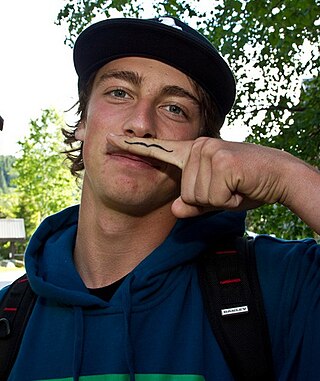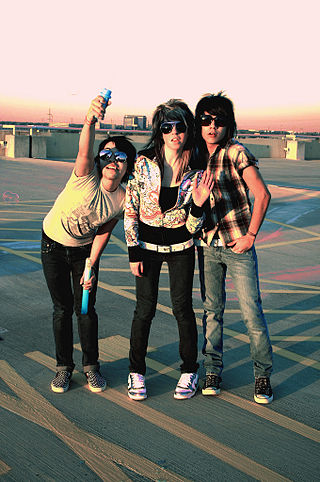Emo is a music genre characterized by emotional, often confessional lyrics. It emerged as a style of hardcore punk and post-hardcore from the mid-1980s Washington, D.C. hardcore scene, where it was known as emotional hardcore or emocore. The bands Rites of Spring and Embrace, among others, pioneered the genre. In the early-to-mid 1990s, emo was adopted and reinvented by alternative rock, indie rock, punk rock, and pop-punk bands, including Sunny Day Real Estate, Jawbreaker, Cap'n Jazz, and Jimmy Eat World. By the mid-1990s, Braid, the Promise Ring, and the Get Up Kids emerged from Midwest emo, and several independent record labels began to specialize in the genre. Meanwhile, screamo, a more aggressive style of emo using screamed vocals, also emerged, pioneered by the San Diego bands Heroin and Antioch Arrow. Screamo achieved mainstream success in the 2000s with bands like Hawthorne Heights, Silverstein, Story of the Year, Thursday, the Used, and Underoath.
In the entertainment industry, sleeper hit refers to a film, television series, music release, video game, or other entertainment product that was unpromising on release but became a surprise success. A sleeper hit may have little promotion or lack a successful launch but gradually develops a fandom following media attention, which in turn increases its public exposure and public interest in the product. As Variety puts it, "A 'sleeper hit' can be defined as the kind of show that catches us by surprise—programs whose popularity grows over time and can ultimately outshine the preordained hits." A sleeper hit often lacks star performers or high production values, but prevails, at times against its own makers' expectations, on the strength of such qualities as narrative, approach, or novelty, as well as market accidents. Sleeper hit films benefit theater owners because the owners keep a larger percentage of money from ticket sales.

Thrift store chic refers to a style of dressing where clothes are cheap and/or used. Clothes are often bought from thrift stores such as the Salvation Army, Goodwill, or Value Village. Originally popular among the hippies of the late 1960s, this fashion movement resurfaced during the mid-1980s among teenagers, and expanded into the 1990s with the growing popularity of such music and style influences including the grunge band Nirvana. Thrift store chic can be considered as an anti-fashion statement because it does not follow fashion trends and does not attempt to look expensive or new.
Streetwear is a style of casual clothing which became global in the 1990s. It grew from New York hip hop fashion and Californian surf culture to encompass elements of sportswear, punk, skateboarding, 1980s nostalgia, and Japanese street fashion. Later, haute couture became an influence, and was in turn influenced by streetwear. Streetwear centers on comfortable clothing and accessories such as jeans, T-shirts, baseball caps, and sneakers. Brands may create exclusivity through intentional product scarcity; enthusiasts follow particular brands and try to obtain limited edition releases, including via proxy purchases.
Post-punk revival is a genre or movement of indie rock that emerged in the early 2000s as musicians started to play a stripped down and back-to-basics version of guitar rock inspired by the original sounds and aesthetics of post-punk, new wave and garage rock. It is closely associated with new wave revival and garage rock revival.

The fashion of the 2000's is often described as a global mash up, where trends saw the fusion of vintage styles, global and ethnic clothing, as well as the fashions of numerous music-based subcultures. Hip-hop fashion generally was the most popular among young people of all sexes, followed by the retro inspired indie look later in the decade.

The 21st-century hipster is a subculture. Fashion is one of the major markers of hipster identity. Members of the subculture typically do not self-identify as hipsters, and the word hipster is often used as a pejorative for someone who is pretentious or overly concerned with appearing trendy.

The scene subculture is a youth subculture that emerged during the early 2000s in the United States from the pre-existing emo subculture. The subculture became popular with adolescents from the mid 2000s to the early 2010s. Members of the scene subculture are referred to as scene kids, trendies, or scenesters. Scene fashion consists of skinny jeans, bright-colored clothing, a signature hairstyle consisting of straight, flat hair with long fringes covering the forehead, and bright-colored hair dye. Music genres associated with the scene subculture include metalcore, crunkcore, deathcore, electronic music, and pop punk.

The 2010s were defined by hipster fashion, athleisure, a revival of austerity-era period pieces and alternative fashions, swag-inspired outfits, 1980s-style neon streetwear, and unisex 1990s-style elements influenced by grunge and skater fashions. The later years of the decade witnessed the growing importance in the western world of social media influencers paid to promote fast fashion brands on Pinterest and Instagram.
The undercut is a hairstyle that was fashionable from the 1910s to the 1940s, predominantly among men, and saw a steadily growing revival in the 1980s before becoming fully fashionable again in the 2010s. Typically, the hair on the top of the head is long and is often parted on either the side or center, while the back and sides are buzzed very short. It is closely related to the curtained hair of the mid-to-late 1990s, although those with undercuts during the 2010s tended to slick back the bangs away from the face.

Soft grunge was a fashion trend that originated on Tumblr around the late 2000s and early 2010s. Beginning as an outgrowth of the 2000s indie sleaze fashion trend but with a greater influence from the 1990s, particularly grunge fashion, the style began as a reaction against the glamor fitness culture which was dominant in popular culture at the time. It is characterized by its merger of cute and aggressive fashion hallmarks like chokers, tennis skirts, leather jackets and boots, flower crowns, distressed denim and pastel colors. Soft grunge reached its peak popularity around 2014, by which time it had been embraced by high fashion designers including Hedi Slimane and Jeremy Scott and been worn by celebrities including Charli XCX. Its internet-based merger of subculture, fashion and music made it one of the earliest examples of an internet aesthetic. In the early 2020s, the style experienced a minor resurgence due to videos posted on the video sharing application TikTok.
Chabad hipsters are the cross-acculturated members of the Chabad Hasidic community and contemporary hipster subculture. Beginning from the late 2000s through the 2010s, a minor trend of cross acculturation of Chabad Hasidism and hipster subculture appeared within the New York Jewish community. The first printed reference to this trend was the 2007 New York Press cover story, "Hipster Hassids" by Alyssa Pinsker. Later, according to The Jewish Daily Forward, a significant number of members of the Chabad Hasidic community, mostly residing in Crown Heights, Brooklyn, appear to now have adopted various cultural affinities of the local hipster subculture.

E-girls and e-boys, sometimes collectively known as e-kids, are a youth subculture of Gen Z that emerged in the late 2010s, notably popularized by the video-sharing application TikTok. It is an evolution of emo, scene and mall goth fashion combined with Japanese and Korean street fashion.

Cottagecore is an internet aesthetic idealising rural life. Originally based on a rural European life, it was developed throughout the 2010s and was first named cottagecore on Tumblr in 2018. The aesthetic centres on traditional rural clothing, interior design, and crafts such as drawing, baking, and pottery, and is related to similar aesthetic movements such as grandmacore, goblincore, gnomecore and fairycore.
Cole Chase Hudson, known professionally as Huddy, is an American singer, actor, and social media personality, known for co-founding the TikTok collective the Hype House, and popularizing the e-boy fashion style and subculture. A 2020 article in Billboard Magazine rated him as one of the top 10 music influencers on TikTok that year, with over 30 million followers, and one of the most influential people on the platform. He has also been cited by Paper as an important figure in the 2020s pop punk revival.

Dark academia is an internet aesthetic and subculture concerned with higher education, the arts, and literature, or an idealised version thereof. The aesthetic centres on traditional educational clothing, interior design, activities such as writing and poetry, ancient art, and classic literature, as well as classical Greek and Collegiate Gothic architecture. The trend emerged on social media site Tumblr in 2015, before being popularised by adolescents and young adults in the late 2010s and early 2020s, particularly during the COVID-19 pandemic.

The fashions of the 2020s represent a departure from 2010s fashion and feature a nostalgia for older aesthetics. They have been largely inspired by styles of the early-to-mid-2000s, late 1990s, 1980s, 1970s, and 1960s. Early in the decade, several publications noted the shortened trend and nostalgia cycle in 2020s fashion. Fashion was also shaped by the COVID-19 pandemic, which had a major impact on the fashion industry, and led to shifting retail and consumer trends.

Mall goths are a subculture that began in the late-1990s in the United States. Originating as a pejorative to describe people who dressed goth for the fashion rather than culture, it eventually developed its own culture based around nu metal, industrial metal, emo and the Hot Topic store chain. It has variously been described as a part of the goth subculture, as well as a separate subculture simply influenced by goth.

Goblincore is an internet aesthetic and subculture inspired by the folklore of goblins, centered on the celebration of natural ecosystems usually considered less beautiful by conventional norms, such as soil, animals, and second-hand objects.
An Internet aesthetic, also simply referred to as an aesthetic or microaesthetic, is a visual art style, sometimes accompanied by a fashion style, subculture, or music genre, that usually originates from the Internet or is popularized on it. Throughout the 2010s and 2020s, online aesthetics gained increasing popularity, specifically on social media platforms such as Tumblr, Pinterest, Instagram, and TikTok, and often were used by people to express their individuality and creativity. They can also be used to create a sense of community and belonging among people who share the same interests. The term aesthetic has been described as being "totally divorced from its academic origins", and is commonly used as an adjective.















